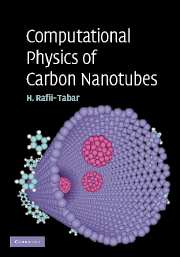Book contents
- Frontmatter
- Contents
- Preface
- 1 Introduction
- Part I
- 2 Formation of carbon allotropes
- 3 Nanoscale numerical simulation techniques
- 4 Interatomic potentials and force-fields in the computational physics of carbon nanotubes
- 5 Continuum elasticity theories for modelling the mechanical properties of nanotubes
- 6 Atomistic theories of mechanical properties
- 7 Theories for modelling thermal transport in nanotubes
- Part II
- References
- Index
5 - Continuum elasticity theories for modelling the mechanical properties of nanotubes
Published online by Cambridge University Press: 29 September 2009
- Frontmatter
- Contents
- Preface
- 1 Introduction
- Part I
- 2 Formation of carbon allotropes
- 3 Nanoscale numerical simulation techniques
- 4 Interatomic potentials and force-fields in the computational physics of carbon nanotubes
- 5 Continuum elasticity theories for modelling the mechanical properties of nanotubes
- 6 Atomistic theories of mechanical properties
- 7 Theories for modelling thermal transport in nanotubes
- Part II
- References
- Index
Summary
Various types of continuum-based elasticity theories have been extensively employed to model the nanomechanics of free-standing SWCNTs, MWCNTs and nanotubes that are embedded in elastic media, such as a polymeric matrix. The results from these modelling studies have been compared with the results obtained from the atomistic-based studies where the discrete nature of the nanotube structure has been explicitly taken into account. Remarkably, as we shall see later on, close agreements have been obtained between these results, indicating that the laws of continuum-based elasticity theories can still be relevant in modelling structures and systems in the nanoscale domains. The continuum-based theories that have been used include the nonlinear thin-shell theories, the theories of curved plates, the theories of vibrating rods and the theories of bending beams. In this chapter we shall present the essential tenets of all these theories, and provide enough details so that the current research materials can be followed and future problems can be formulated with their aid.
Basic concepts from continuum elasticity theory
Hooke's laws in isotropic elastic materials
Let us first consider some of the essential topics from the theory of elasticity that are routinely employed in studies concerned with the mechanical properties of solid structures.
- Type
- Chapter
- Information
- Computational Physics of Carbon Nanotubes , pp. 135 - 185Publisher: Cambridge University PressPrint publication year: 2007



